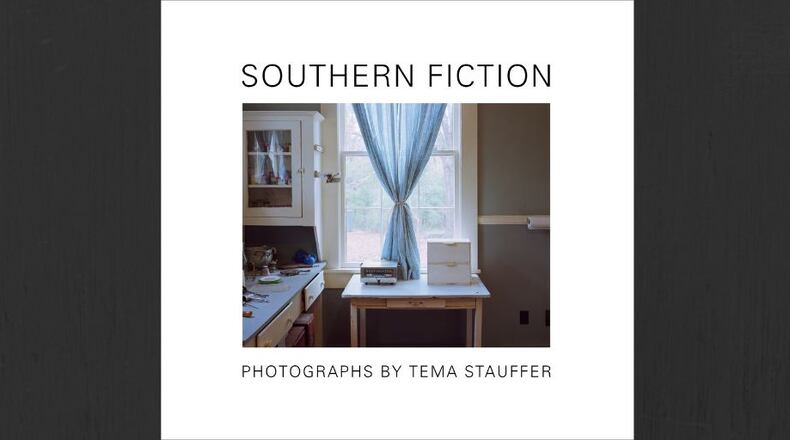When it comes to coffee table books, photography often figures prominently because it’s a natural fit. This year’s crop of books is no different, but the offerings also include some unusual outliers, which makes them great gift ideas for those on the list who are hard to buy for. And there’s nothing to say you can’t buy them for yourself, of course. The hard part is picking just one.
Photographs of the South featuring lush green landscapes, dilapidated tin-roof shacks, weathered fruit stands, old cars and white clapboard churches are not uncommon. Sally Mann and William Eggleston built their careers upon their unique interpretations of those subjects. But this collection by Tema Stauffer takes a different approach. She focuses on the homes of famous Southern writers and the surrounding environments that contributed to their literary output. Shacks, churches and cars are represented here, but what stands out are the evocative, softly lit, large format photographs of the blue gingham curtains hanging from a window in William Faulkner’s kitchen; the chenille-embroidered spread on Eudora Welty’s ornate bed; the faded horse barn on Flannery O’Connor’s farm; and the stark white church where Alice Walker was baptized. Accompanying the images are a trio of essays including one from Honorée Fanonne Jeffers, author of “The Love Songs of W.E.B. DuBois,” who befriended the photographer after seeing an Instagram post of the iconic “peches” fruit stand in Eatonton, where Jeffers’ mother was born. She reflects on how age has softened her complicated relationship with the South, which she describes as “the place that conjured glory and ruins in my imagination.” (Daylight, $50)
Credit: Handout
Credit: Handout
Nobody knows how to use photographs to tell a story like documentarian Ken Burns. In this hefty, large format coffee table book, Burns provides an historical account of the USA by presenting 200 black-and-white images chronologically from 1839 to 2019. Instead of glorifying the country, “Our America” takes a warts-and-all approach to the telling. There are plenty of images that capture the majesty of the land (Devil’s Tower in Wyoming, the Great Smoky Mountains, the Sierra Madres) and the dignity of its people (Ernest Hemingway, Lou Gehrig, Rosa Parks), but there are just as many that reflect the ugly side of American life (slavery, war, poverty). Georgia is well represented, including two particularly striking images. One is of a Black man slapping a Black woman in Atlanta in 1960 by James Karales. It was taken at a training session in nonviolent protest presented by the Student Nonviolent Coordinating Committee. The other is the final image in the book, an elegiac portrait by Michael Avedon of the late U.S. Rep. John Lewis taken the year before his death. (Alfred A. Knopf, $75)
Credit: Handout
Credit: Handout
“Hello Everybody.” That’s how punk rock goddess Patti Smith starts her charming, low-fi vlogs typically recorded late at night from the foot of her unmade bed. Available on Substack, her posts are just a few minutes long, delivered between welcomed interruptions from Cairo the cat. Smith chats in a rambling, circuitous way about her favorite obsessions — books, art, dead artists and writers, friends and family, both here and gone. Those same topics fill the pages of this thick, diary-sized book of 366 candid photos and observations, one for each day of the year, plus one for leap year. The photos are culled from her decades-long hobby of taking Polaroid pictures plus newer images taken on her cell phone. Common themes include cups of coffee in cafes, often with a notebook and pen nearby; the birthdays of artists, writers and intellectuals; candid shots of family and friends; landscapes and buildings from her travels in Europe; and favorite articles of clothing including an Alexander McQueen T-shirt given to her by Michael Stipe upon the designer’s death. And each is accompanied by a snippet of poetic observation. The overall result is endearing and meditative. (Random House, $28.99)
Credit: Handout
Credit: Handout
“The Paper Dolls of Zelda Fitzgerald”
Zelda Fitzgerald had a number of creative pursuits, but perhaps one of her quirkiest was the creation of paper dolls. Old timers like me who recall playing with paper dolls as a child will enjoy the stroll down memory lane. Others can appreciate the artistry of Fitzgerald’s creations and the elaborate, detailed fashion designs. There are dolls that represent Zelda and her famous husband, F. Scott Fitzgerald, as well as their daughter Scottie, for whom the dolls were created. And there are complete sets of dolls with costume changes that tell the stories of Goldilocks and the Three Bears, the Three Musketeers, Hansel & Gretel, King Arthur and the Knights of the Round Table, Little Red Riding Hood and the Court of Louis XIV. The book is compiled by the Fitzgeralds’ granddaughter, Eleanor Lanahan, who provides the preface. (Scribner, $25.99)
Credit: Steidl/The Gordon Parks Foundation
Credit: Steidl/The Gordon Parks Foundation
“Gordon Parks: Segregation Story”
This book of color images by one of the greatest photographers of all time, Gordon Parks, started as a 1956 photo essay in Life magazine that illustrated what life was like for the Thorntons, a Black family living in the Jim Crow South. A larger collection of images from that series was published in a book in 2014. Since then more images have been discovered, resulting in this new, expanded edition that includes a reproduction of the Life magazine spread and Parks’ typed notes on the images. There are also several essays including “Doing the Best We Could with What We Had” by Charlayne Hunter-Gault and “Gordon Parks: The South in Color” by Dawoud Bey. Many of the images from this series are iconic, like the one of a young woman and little girl, dressed in their Sunday finest, standing beneath a neon “colored entrance” sign. Parks’ images are gorgeous to look at. They are beautifully composed, startlingly intimate and suffused in soft colors, making the ugliness of their subject — segregation — all the more disturbing. (Steidl/The Gordon Parks Foundation, $65)
Credit: Handout
Credit: Handout
“Mid-Century Modern Furniture”
The collective obsession with mid-century modern design has been with us for a while now and shows no signs of letting up. There’s just something so crave-worthy about those clean lines, organic shapes and unfussy focus on function over form. Like a modern-day Sears & Roebuck wish book for collectors, this hefty coffee table book features more than 450 big, full-color photographs that capture a comprehensive survey of furniture from the period. We’re talking an entire chapter just on stools. All the classic designers are represented: Ray and Charles Eames, Herman Miller, Marcel Breuer, Mies van der Rohe, Piet Hein, etc. But there are also plenty of rare, lesser known designs, too. Equal parts inspirational and envy-inducing, this book is sure to delight even the most discerning collectors. (Thames & Hudson, $75)
Credit: Handout
Credit: Handout
For those who approach bad news by laughing to keep from crying, consider this compendium of official documentation on how to survive a litany of disasters by Taras Young. Entries are culled from around the world and date back more than 100 years. In addition to humorous and ironic vintage illustrations and some dubious, outdated advice, there is useful advice, too. It’s up to the reader to decide which is which. The book appropriately starts with a chapter on pandemic. It includes a full-color illustration of how to avoid tuberculosis created by the Shanghai Relief Society for the Elderly in 1953 and a section on AIDS/HIV. In a chapter on natural disasters, there’s a full-color illustration on how to respond to an earthquake from the Soviet Union in 1986. A chapter on nuclear war features a chilling illustration of a family huddled in a steel pipe buried underground from the U.S. in 1961. The final chapter, on alien invasion, includes a guide to 31 flying saucers to help ‘80s-era New Zealanders identify UFOs. If you aren’t worried when you begin this book, you will be when you’re done. (Thames & Hudson, $47)
About the Author
The Latest
Featured







